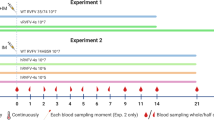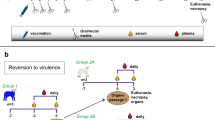Summary
Rift Valley fever (RVF) is a major cause of human morbidity and mortality in endemic areas of sub-Saharan Africa and has the potential to cause epidemic disease in receptive areas world-wide. In this study, a RVF viral isolate from the 1977 Egyptian epidemic (ZH-501) inoculated intravenously into rhesus macaques caused a benign viremic infection in most, but resulted in the hemorrhagic fever syndrome in 20 per cent (3 of 15). Serious disease of this type has not previously been observed in nonhuman primates inoculated with RVF virus and may be a consequence of the viral strain used or the route of inoculation. Severe disease was accompanied by extensive liver necrosis, disseminated intravascular coagulation, and microangiopathic hemolytic anemia.
We also attempted to prevent RVF by passive transfer of serum from vaccinated rhesus monkeys (plaque-reduction neutralization test titer 1:2,560). As little as 0.025 ml/kg prevented the development of viremia in naive rhesus monkeys after subcutaneous inoculation of virus. The monkey model should be helpful in understanding the pathogenesis and prevention of human RVF.
Similar content being viewed by others
References
Anderson GW Jr, Slone TW Jr, Peters CJ (1987) Pathogenesis of Rift Valley fever virus (RVFV) in inbred rats. Microbial Pathogen 2: 283–293
Cash P, Robeson G, Erlich BJ, Bishop DHL (1981) Biochemical characterization of Rift Valley fever and other phlebotomus fever group viruses. Contrib Epidemiol Biostatist 3: 1–20
Centers for Disease Control and National Institute of Health (1984) Biosafety in microbiological and biomedical laboratories, 1st edn. U.S. Department of Health and Human Services, Public Health Services.
Colman RW, Robboy SJ, Minna JD (1979) Disseminated intravascular coagulation: a reappraisal. Ann Rev Med 30: 359–374
Davies FG, Clausen B, Lund LJ (1972) The pathogenicity of Rift Valley fever virus for the baboon. Trans R Soc Trop Med Hyg 66: 363–365
Easterday BC (1965) Rift Valley fever. Adv Vet Sci 10: 65–127
Eddy GA, Peters CJ, Meadors G, Cole FE Jr (1981) Rift Valley fever vaccine for humans. Contrib Epidemiol Biostatist 3: 124–141
Findlay GM (1932a) Rift Valley fever or enzootic hepatitis. Trans R Soc Trop Med Hyg 25: 229–265
Findlay GM (1932b) The infectivity of Rift Valley fever for monkeys. Trans R Soc Trop Med Hyg 26: 161–168
Findlay GM, MacKenzie RD, Stern RO (1936) Studies on neurotropic Rift Valley fever virus: the susceptibility of sheep and monkeys. Br J Exp Pathol 17: 431–441
Halstead SB (1981) The Alexander D. Langmuir Lecture. The pathogenesis of dengue. Molecular epidemiology in infectious disease. Am J Epidemiol 114: 632–648
Kark JD, Aynor Y, Peters CJ (1982) A Rift Valley fever vaccine trial. I. Side effects and serologic response over a six-month follow-up. Am J Epidemiol 116: 808–820
Kitchen SF (1950) The development of neurotropism in Rift Valley fever virus. Ann Trop Med Parasitol 44: 132–145
Linthicum KJ, Davies FG, Kairo A, Bailey CL (1985) Rift Valley fever virus (family Bunyaviridae, genusPhlebovirus). Isolations from diptera collected during an interepizootic period in Kenya. J Hyg (Camb) 95: 197–209
Lupton HW, Peters CJ, Eddy GA (1982) Rift valley fever: global spread or global control? Ann Meet U.S. Animal Hlth Assoc 86: 261–275
Niklasson BS, Meadors GF, Peters CJ (1984) Active and passive immunization against Rift Valley fever virus infection in Syrian hamsters. Acta Pathol Microbiol Immunol Scand [C] 92: 197–200
Peters CJ, Anderson GW Jr (1981) Pathogenesis of Rift Valley fever. Contrib Epidemiol Biostatist 3: 21–41
Peters CJ, Slone TW (1982) Inbred rat strains mimic the disparate human response to Rift Valley fever virus infection. J Med Virol 10: 45–54
Peters CJ, LeDuc JW (1984) Bunyaviruses, phleboviruses and related viruses. In: Belshe RB (ed) Textbook of human virology. PSG, Littleton, Massachusetts, pp 547–598
Peters CJ, Jahrling PB, Liu CT, Kenyon RH, McKee KT Jr, Barrera Oro JG (1987) Experimental studies of arenaviral hemorrhagic fevers. Curr Top Microbiol Immunol 134: 5–68
Reynolds JA, Harrington DG, Crabbs CL, Peters CJ, Di Luzio NR (1980) Adjuvant activity of a novel metabolizable lipid emulsion with inactivated viral vaccines. Infect Immun 28: 937–943
Van Velden DJJ, Meyer JD, Olivier J, Gear JHS, McIntosh B (1977) Rift Valley fever affecting humans in South Africa. A clinicopathological study. S Afr Med 51: 867–871
Vassef AA (1978) Direct micromethod for colorimetry of serum ornithine carbamoyltransferase activity, with use of a linear standard curve. Clin Chem 24: 101–107
World Health Organization (1979) Rift Valley fever surveillance. Weekly Epidemiol Rec 54: 293–294
Author information
Authors and Affiliations
Rights and permissions
About this article
Cite this article
Peters, C.J., Jones, D., Trotter, R. et al. Experimental Rift Valley fever in rhesus macaques. Archives of Virology 99, 31–44 (1988). https://doi.org/10.1007/BF01311021
Received:
Accepted:
Issue Date:
DOI: https://doi.org/10.1007/BF01311021




